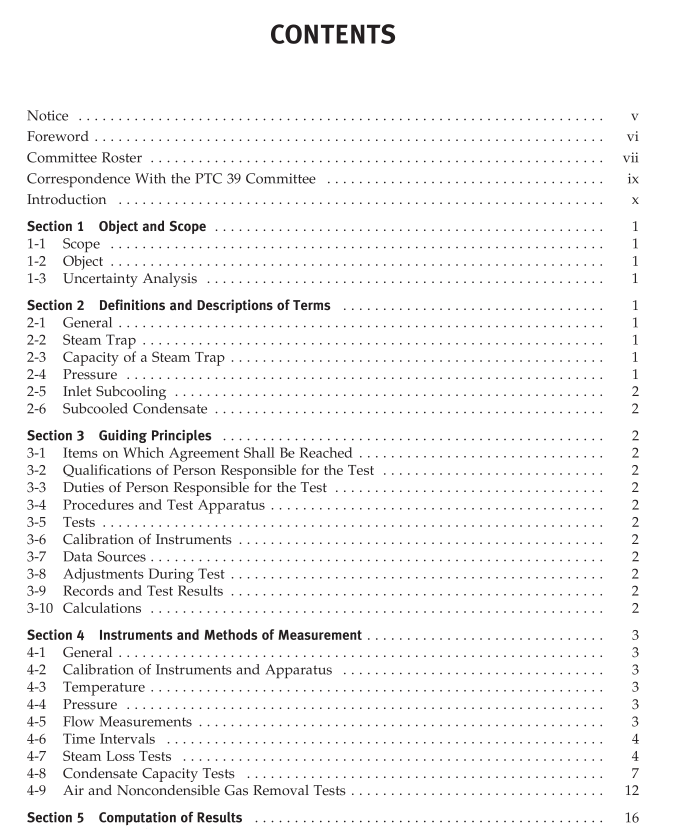ASME PTC39:2005 pdf free download Steam Traps
4-1 GENERAL If any revisions are made to the methods and guid- ance provided in this Code, the estimation of their ef- fect on test uncertainty shall be made and understood by all parties to the test. This Section presents the mandatory requirements for the instruments, methods, and precautions which shall be employed. The Instrument & Apparatus (I&A) Supplements should be con- sulted if sufficient information is not included in this Section. By mutual agreement of the parties to the test, alternative instrumentation or instrument systems, such as flow metering or mass-flow techniques, may be used, provided that such devices or systems have demonstrated accuracy equivalent or greater to that required by this Code.
4-2 CALIBRATION OF INSTRUMENTS AND APPARATUS Instruments and apparatus used for determination under this Code shall be calibrated in accordance with their respective I&A Supplement.
4-3 TEMPERATURE Temperature measurements shall be carried out in ac- cordance with accepted practices and procedures as discussed in the I&A Supplement on Temperature Mea- surement, PTC 19.3. Temperature shall be measured to within ?0.75°F (0.4 K). To meet this accuracy require- ment, temperature shall be measured with resistance thermometers or calibrated thermocouples used with precision reading instruments. Liquid-in-glass ther- mometers may be used for such secondary readings as ambient temperature for manometers and barometers. If liquid-in-glass thermometers are used to measure other variables, they must be calibrated, stem correc- tions must be applied, and graduations must be such that a precision of 0.2°F (0.1 K) is observable. Stagnation thermometer wells shall be used or computed velocity correction applied when the average steam velocity at the sensing point exceeds 300 ft/sec (100 m/s). When the degree of subcooling is 10°F (6 K) or less, the difference shall be measured by differential tem- perature sensing devices as prescribed in PTC 19.3.
4-4 PRESSURE Pressure measurements shall be carried out in accor- dance with the I&A on Pressure Measurement, PTC 19.2. Pressure transmitters, electronic pressure indicators, calibrated elastic gages, or manometers shall be used for reading constant or slowly varying pressures.
(a) Manometers shall be of the vertical U-tube or sin- gle leg type with a minimum bore of 5 / 16 in. (8 mm). Spacing between scale graduations shall not be more than 1 / 8 in. (3 mm). In a single leg manometer, means shall be available for adjusting the scale zero while the instrument is in use. Manometers shall be selected such that the scale length and the manometer fluid density permit a reading accuracy to within ?0.5% of the mea- sured pressure or pressure differential.
(b) Deadweight gages shall be selected with weights suitable for the pressure range to be measured in ac- cordance with PTC 19.2.
(c) Bourdon gages or other elastic gages may be used for measurements of pressure provided that they are calibrated against a deadweight gage before and after the test. The ambient temperature of the gage during calibration shall be within 20°F (10 K) of the ambient temperature pre- vailing during the Code test. The diameter of the scales and the arrangement of graduations shall permit readability to within ?1.0% of the pressure being measured.
(d) Barometric pressure shall be measured to an ac- curacy within ?0.1 in. (2.5 mm) of mercury. The barom- eter shall be located in a stable environment at the test site and shall sense the same pressure as that of the gages and manometers used for the Code test. PTC 19.2 should be used for the procedure for care and mainte- nance, and the application of appropriate corrections.
(e) Electronic indicators or transmitters used for pres- sure measurement shall be 0.1% accuracy class and have a total uncertainty of 0.3% or better of calibrated span. These pressure instruments should be temperature com- pensated. If temperature compensation is not available, the ambient temperature at the measurement location during the test period must be compared to the tem- perature during calibration to determine if the decrease in accuracy is acceptable.
4-5 FLOW MEASUREMENTS Flow measurements shall be made in accordance with the following paragraphs.
4-5.1 Weigh Tanks Suitable tanks and scales shall be calibrated prior to use and caused to weigh to a measurement accuracy of within ?0.5% in the range of the loads to be weighed. Design, construction, calibration, and operation of weighing tanks shall be in accordance with the I&A on Weighing Scales, PTC 19.5.1.
4-5.2 Volumetric Tanks Volumetric tanks shall be calibrated prior to use and caused to measure to an accuracy within ?0.5% in the
ASME PTC39:2005 pdf free download
